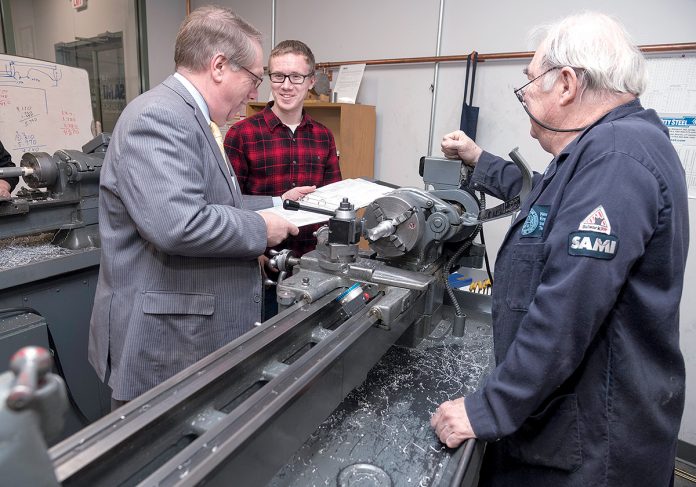Since his start as Polaris MEP center director four years ago, Christian Cowan has watched the state’s manufacturing industry blossom. So much so, he said, those companies are scrambling to fill employment “gaps.”
And it’s not just the smallest state in the union that is experiencing this resurgence.
According to the Institute for Supply Management’s “Report on Business” released Jan. 3, the manufacturing industry is healthy nationwide. Most notably, the report showed the new-orders index for December 2017 was the largest recorded since 2004 at 69.4 percent, an increase from 64 percent in November.
The report also said the industry’s purchasing managers index, a measure of the economic health of the industry, was 59.7 percent – an increase of 1.5 percentage points from November and indicative of growth.
The boom described by the data, said Cowan, “has definitely translated here on the local scene.”
In line with Cowan, industry insiders and observers agree local manufacturing is witnessing increased productivity, demand and output. Besides the well-known products manufactured in Rhode Island that bring the spotlight here once a year – the Vince Lombardi trophy, the annual White House Historical Association ornament – they say major gains have been made in military defense, textile, composite, machine and contract subsectors.
Cowan noted multiple factors are behind the industrywide success. “It’s very encouraging to me to see manufacturing companies growing, but also growing in the right way,” said Cowan of their increased use of technology and “skilling up” their new workforce.
Calling it “one of the most dynamic workforce-development programs” to be executed in the state, Cowan believes state-sponsored Real Jobs Rhode Island training is “part of the reason why [Rhode Island] is ready to handle” the boom.
The most calls for new and skilled workers Cowan has seen lie in two subsectors – military defense and the “merge” of textiles and composite producers.
Topping the list is military defense. North Kingstown’s General Dynamics Electric Boat, for example, called for the hiring of 2,000 new employees in 2017 and another 1,000 in 2018.
Smaller companies that make up the supply chain for larger corporations, such as GDEB, are also reaping the benefits, said David M. Chenevert, Rhode Island Manufacturers Association executive director. The “trickle down” of business to “ancillary” companies underlines local success, said Chenevert.
Once held back by their minimal use of technology and lack of “progressive thinking,” Cowan said the textile and composite industries have turned themselves around. Now helping to develop the latest in wearable technology and implementation of sensors into bridges and roads, recent years have seen “a very positive turnaround” for both sectors, he said.
Raymond W. Fogarty, director of Bryant University’s John H. Chafee Center for International Business, said this prioritization of innovation creates a paradox. Rhode Island’s manufacturing industry is a “historic” one, dating back to the origins of the Industrial Revolution, he said, yet local firms are painted as “up and coming” in the national context.
Steven H. Kitchin, New England Institute of Technology vice president for corporate education and training, shares Cowan’s outlook: “The bottom line is manufacturing has an awful lot of reasons to be optimistic.”
Kitchin has experienced the manufacturing resurgence fielding phone calls from Rhode Island businesses looking to hire graduates of the school’s 5-year-old Shipbuilding Advanced Manufacturing Institute. However, he added, there are still hurdles to overcome for the industry to sustain such growth.
Estimating the size of the state’s manufacturing workforce as between 41,000 and 42,000, Kitchin said, moving forward, “If there is anything in the Rhode Island portfolio that might restrict growth, it is a supply of talent.”
‘The bottom line is manufacturing has an awful lot of reasons to be optimistic.’
STEVEN H. KITCHIN, NEIT vice president for corporate education and training
The en masse retirement of baby boomers and the minimal number of new workers lining up to take their place are still concerns, he explained, adding the state has the “tools to address it a lot better than we have [done] in the past.”
The “primary supply of talent for defense manufacturing and machine-tool manufacturers,” said Kitchin, the SAMI program trains the workers Cowan knows are helping to sustain and innovate the industry.
Because the demand is so high for skilled manufacturers today, Kitchin knows any SAMI graduate will have a “very, very high” likelihood of securing work immediately after graduation, if not before. In fact, he added, to date more than 110 employers have hired SAMI graduates.
While industry insiders remain upbeat, many are aware of multiple challenges facing Rhode Island’s manufacturers heading into 2018.
Local businesses may “have a better opportunity to capitalize than they used to,” said Cowan, however, keeping up with the evolution of technology and addressing the changing demographic of the next generation of the workforce continue to challenge the industry, added Kitchin.












